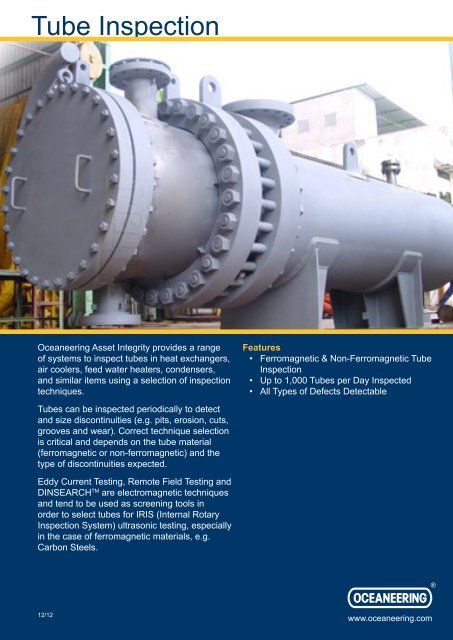Tube Inspection - Oceaneering
Tube Inspection - Oceaneering Tube Inspection - Oceaneering
Tube InspectionTypical ReportOceaneering Asset Integrity provides a rangeof systems to inspect tubes in heat exchangers,air coolers, feed water heaters, condensers,and similar items using a selection of inspectiontechniques.Features• Ferromagnetic & Non-Ferromagnetic TubeInspection• Up to 1,000 Tubes per Day Inspected• All Types of Defects DetectableTubes can be inspected periodically to detectand size discontinuities (e.g. pits, erosion, cuts,grooves and wear). Correct technique selectionis critical and depends on the tube material(ferromagnetic or non-ferromagnetic) and thetype of discontinuities expected.Eddy Current Testing, Remote Field Testing andDINSEARCH TM are electromagnetic techniquesand tend to be used as screening tools inorder to select tubes for IRIS (Internal RotaryInspection System) ultrasonic testing, especiallyin the case of ferromagnetic materials, e.g.Carbon Steels.12/12www.oceaneering.com
<strong>Tube</strong> <strong>Inspection</strong>Typical Report<strong>Oceaneering</strong> Asset Integrity provides a rangeof systems to inspect tubes in heat exchangers,air coolers, feed water heaters, condensers,and similar items using a selection of inspectiontechniques.Features• Ferromagnetic & Non-Ferromagnetic <strong>Tube</strong><strong>Inspection</strong>• Up to 1,000 <strong>Tube</strong>s per Day Inspected• All Types of Defects Detectable<strong>Tube</strong>s can be inspected periodically to detectand size discontinuities (e.g. pits, erosion, cuts,grooves and wear). Correct technique selectionis critical and depends on the tube material(ferromagnetic or non-ferromagnetic) and thetype of discontinuities expected.Eddy Current Testing, Remote Field Testing andDINSEARCH TM are electromagnetic techniquesand tend to be used as screening tools inorder to select tubes for IRIS (Internal Rotary<strong>Inspection</strong> System) ultrasonic testing, especiallyin the case of ferromagnetic materials, e.g.Carbon Steels.12/12www.oceaneering.com
<strong>Tube</strong> <strong>Inspection</strong>Internal Rotary <strong>Inspection</strong> System (IRIS)IRIS consists of a high frequency ultrasonicimmersion probe inside a rotating test head usedto examine tubes for internal / external corrosion orerosion damage. It can accurately measure remainingwall thickness in most instances.Features:• <strong>Inspection</strong>, typically 70 - 100 tubes per shift• Can test all of the tube (straight lengths only)• Applicable to most materials• Accurate wall thickness measurement• Sensitivity - 1.5 Mm diameter, 5% loss (variablewith tube size / cleanliness)• Not affected by baffle plate / tube sheet• <strong>Tube</strong> has to be flooded• Bore surface has to be very clean• Cannot detect cracks• Requires 110 / 240 volt power supply & potablewater suppliesEddy Current TestingEddy Current Testing is an electromagnetic techniquefor the rapid inspection of non-ferromagnetic tubesand is capable of detecting internal and externaldefects. An Eddy Current field is induced in the tubeunder test and defects present will influence thecharacteristics of this field.Features:• <strong>Inspection</strong>, typically 500 - 1,000 tubes per shift• Computerized analysis• Can be used as a standalone technique• Cleanliness is less critical than for IRIS• Bends can be tested using special probes• Cracking is detectable• Less accurate than IRIS• Can only be applied to non-ferromagnetic tubes• Reference tube of same size & specification astubes under test required• May require IRIS back-up for critical applications• Defects close to the tube sheet are difficult todetect• Requires 110 / 240 volt power supplyRemote Field TestingRemote Field Testing is an electromagnetic techniquefor the inspection of ferromagnetic tubes. Thetechnique is based on measuring the amplitudeand phase lag of the remote eddy current field. Thetechnique has good detection and measurementcapability for general thinning, but sensitivity to pittype defects can be more limited.Features:• <strong>Inspection</strong>, typically 500 tubes per shift• Equally sensitive to ID & OD defects• Computerized analysis• Good for general wall losses• Phase plane analysis allows estimation of wallloss• Cleanliness not critical• Sensitivity to pitting can be limited (material &tube size dependent)• Speeds typically from 0.1 - 0.5 m/s• Faster than IRIS, but slower than otherelectromagnetic methods• Requires 110 / 240 volt power supplyDINSEARCH TM (Magnetic Bias)DINSEARCH TM is an electromagnetic technique forthe rapid inspection of ferromagnetic tubes and iscapable of detecting internal and external defects.Conventional eddy current techniques cannot beapplied to ferromagnetic tubes due to their highmagnetic permeability that results in low fieldpenetration and high noise levels. The DINSEARCH TMtechnique relies on partial magnetic saturation of thetube using electromagnets. The presence of defectsin the tube causes variations in magnetic flux densitythat are detected using eddy current sensors. Thetechnique can provide an indication of tube condition,but wall loss measurement capability is very limited.Features:• <strong>Inspection</strong>, typically 500-1,000 tubes per shift• Ferromagnetic materials can be inspected• Cleanliness is less critical than for IRIS• Poor wall thickness measurement capability• Calibration tube required• IRIS backup is essential in most cases• To be used as a screening tool only!• Will not detect generally thinned tubes• Requires 110 / 240 volt power supply<strong>Oceaneering</strong> International, Inc. | Asset Integrity | 11911 FM 529 | Houston, TX 77041email: Asset-Integrity@oceaneering.com | oceaneering.com/asset-integrityOCEANEERING ® is a registered trademark of <strong>Oceaneering</strong> International, Inc.DINSEARCH TM is a registered trademark of Dinsley Devices Ltd.



